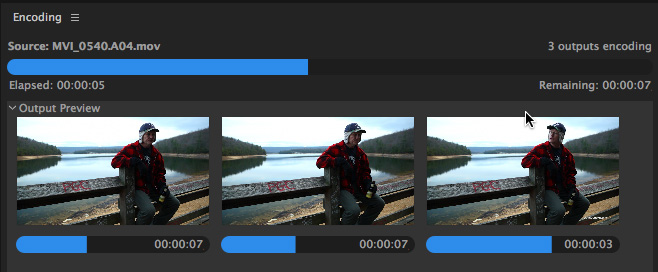 Each week, when I finish editing my webinar and all its excerpts, I need to create several different versions of each file:
Each week, when I finish editing my webinar and all its excerpts, I need to create several different versions of each file:
While its entirely possible to import each file that needs compression, apply compression settings manually, then compress the file, it is much easier to automate the entire process.
Adobe Media Encoder makes this possible using Watch Folders. A Watch Folder is a folder you create on your Desktop (or a server) that AME “watches.” When you drop a source file into the folder, AME will compress that file according to the settings you’ve applied to that Watch Folder inside AME.
The only rule is that Adobe Media Encoder must be running in order for Watch Folders to work. Here’s how to set one up.
GET STARTED

In the Finder, I’ve created a folder named “Compress for YouTube”.
NOTE: There’s nothing special to this name, you can name the folder anything you want.

Open Adobe Media Encoder and click the Watch Folders tab.
To enable Watch Folders, click the Plus icon. Then, navigate to the folder you want AME to watch and click Choose.
NOTE: In this article, I’m using the 2017 version of AME, but Watch Folders have existed in the app for years, though their position in the interface frequently moves.

The folder you select instantly appears in the window, with an assigned preset. Most of the time, this will not be the preset you want. Not to worry, it is easy to change.

To replace one preset with another, drag the one you want to use from the Preset Browser – here, I’m using the YouTube 720 preset – and dropping it on top of the preset you want to replace in the Watch Folders pane.

To create multiple versions of the same source file, drag additional presets on top of the source file name. Here, I assigned three different compression presets to the same folder. You don’t need to create different folders for each compression setting.
NOTE: To remove a preset, select it, then press the Delete key.
CHANGE DESTINATIONS
By default, AME stores compressed files in the Output folder inside the watched folder.
NOTE: Changing Output settings in preferences does not affect Watch Folder settings.

You can change the default destination for any setting in the Watch Folder by double-clicking the Output Folder name. For example, here, I created three different versions of my file:
You can add folders and change destinations as much as you want.

When you are done, click the Queue tab. By default, because Auto-Encode Watch Folders is checked, AME will “check” that Watch Folder every few seconds to see if a new file was added.
START WATCHING

When a file is added to the watched folder, as soon as that file is transferred and the transfer is complete, AME starts compressing the file based upon the settings you applied to that Watch folder.
If more than one compression setting was applied to that folder, AME compresses multiple settings at once. I like this simultaneous compression feature a lot!

When each file is done, AME moves it into the appropriate output folder, as you can see here. This makes it easy to tell which files were compressed with which setting.
Notice, also, that AME moved the source file into the Source folder (which it created automatically) so that you know whether a file was compressed or not, and to prevent a continuous compression “loop.”
SUMMARY
Watch Folders are a fast and efficient way to process lots of files automatically without any manual intervention.
This works especially well for files that are stored on a server, where AME is able to process files from multiple edit stations at the same time. Destinations are determined by compression preset.

The only downside to using Watch Folders is that Adobe Media Encoder needs to be running in order for it it sense when a file is ready to be compressed. This might impact the performance of other software running on the same system, depending upon how much RAM is assigned to AME.
If you are doing lots of compression, and you want to use Watch Folders, it would make sense to dedicate a system simply for video compression.